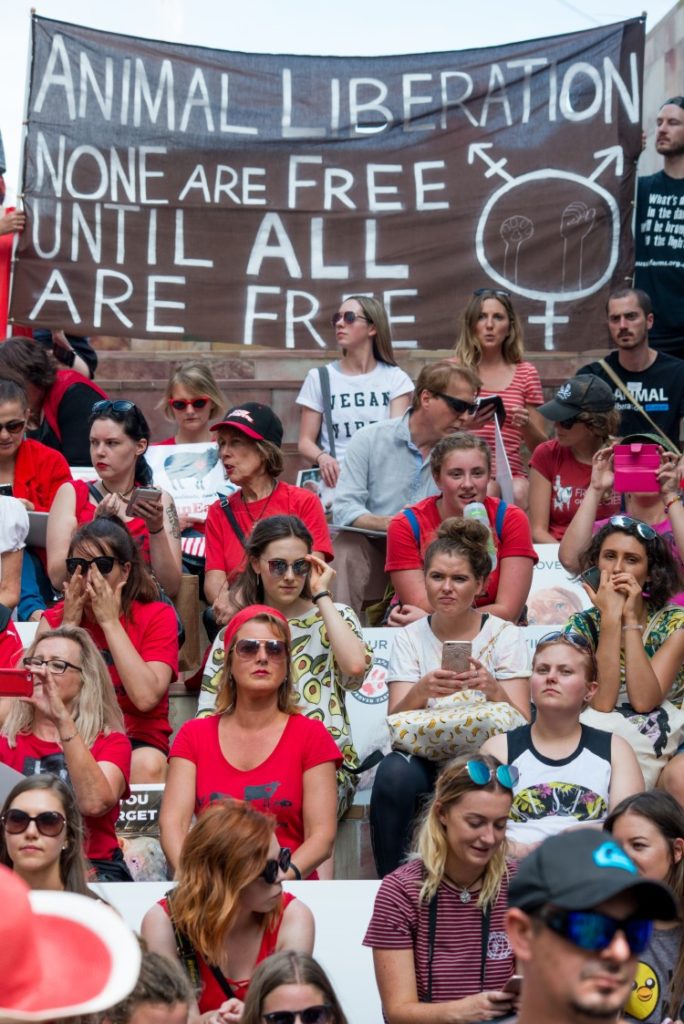Written by Jamie Berger
Effectiveness has become a cornerstone principle of the professional vegan movement. Many of the largest animal protection organizations –– and several of the smaller ones –– now carefully evaluate how to use their budgets most strategically to boost their own version of the “bottom line”: the number of animals spared from suffering. By adopting this approach, we’ve achieved monumental successes for animals with our relatively modest resources.
But there may be a downside to this calculus-driven method of ending animal cruelty –– one even those of us who embrace utilitarian philosophies should face head on. In striving to do good better and do the most good they can do, the leaders of the professional farmed animal protection movement (92 percent of whom are white, and the majority of whom are male, according to an informal analysis conducted in 2017) have often left racial diversity, equity, and inclusion efforts out of the effectiveness equation.
When we look at the number of leaflets we distribute, the views we accumulate on videos exposing animal cruelty, the number of people who pledge on a website to go vegetarian, the media hits we get, or even the plant-based products we sell –– and crunch these numbers into the number of animals spared –– we may overlook other important indicators of success.
Were our leaflets and videos accessible to a broad range of audiences, or did they speak only to a privileged few? Did those media hits help us reach people in an inclusive way, or did they alienate some of the audiences we’re trying to persuade? And were all these materials created and programs carried out by groups of people who represent the world they’re striving to change, or were they done by homogenous groups with narrow perspectives?
For too long, our movement has avoided asking questions like these. An animal life spared is an animal life spared, we say; why should the equation include anything else? But the means to our collective end do matter, and we risk losing relevancy –– and effectiveness –– in the long term if we don’t find ways to bring diversity, equity, and inclusion into our strategy.
Why? For starters, exclusive advocacy limits our impact. By 2044, people of color will comprise the majority of the U.S. population, and we can’t expect to change the world if our approach only resonates with a select group of people or isolates us from other social justice movements. Especially given that race and racism have taken center stage in American politics and culture, the fact that nearly 90 percent of staff at the top 20 farmed animal protection organizations are white is not easily overlooked.

Second, solid evidence from the for-profit world suggests diverse organizations are more successful than homogenous ones. A McKinsey & Company study found that ethnically diverse companies are 35 percent more likely to perform better financially than the national industry median. In addition, a study from Bersin by Deloitte found that diverse companies had 2.3 times higher cash flow per employee over a three-year period than non-diverse companies did. It’s no wonder business behemoths like Walmart, Apple, Google, Exxon, and Microsoft are all prioritizing diversity and inclusion efforts.
Of course, animal protection organizations are not just interested in “cash flow” but in the amount of good we can do. We have every reason to believe that these findings from the for-profit world will translate to our own objectives. Social science research tells us that diverse teams are more innovative and more likely to analyze facts objectively than homogenous ones.
We’re starting to make progress.
Compared to even a few years ago, people of color have more representation in our movement’s print and online materials, videos, and other media. We’re striving to do this without tokenizing people by highlighting the powerful work people of color are already doing –– and by going beyond simple “cosmetic” diversity (sometimes we fall short, but we’re continually striving to be better). We’ve become more aware of how our messaging resonates with a broader spectrum of audiences. We’ve expanded our advocacy to other regions of the world and are being mindful to avoid imperialism whenever possible. We’ve made efforts to minimize unconscious bias in our hiring practices. Diversity and inclusion are now subjects of discussion at our conferences and in our conference rooms, and a few organizations, including Animal Charity Evaluators –– an organization grounded in Effective Altruist principles — have even embedded these topics into their internal and external strategies.
But we have a long way to go, especially when it comes to making the professional farmed animal protection movement more welcoming for people of color.
Utilitarian philosophies and a focus on bottom-line effectiveness have brought the animal protection movement so far –– but we can’t expect to go much further unless these principles encompass more of the things that matter.
Jamie Berger is Media Production Manager at Mercy For Animals. She currently oversees a global team of media professionals who bring inspiring, educational video content to hundreds of millions of people worldwide.
Featured image: who is included in our movement? Image credit Jo-Anne McArthur / We Animals.





